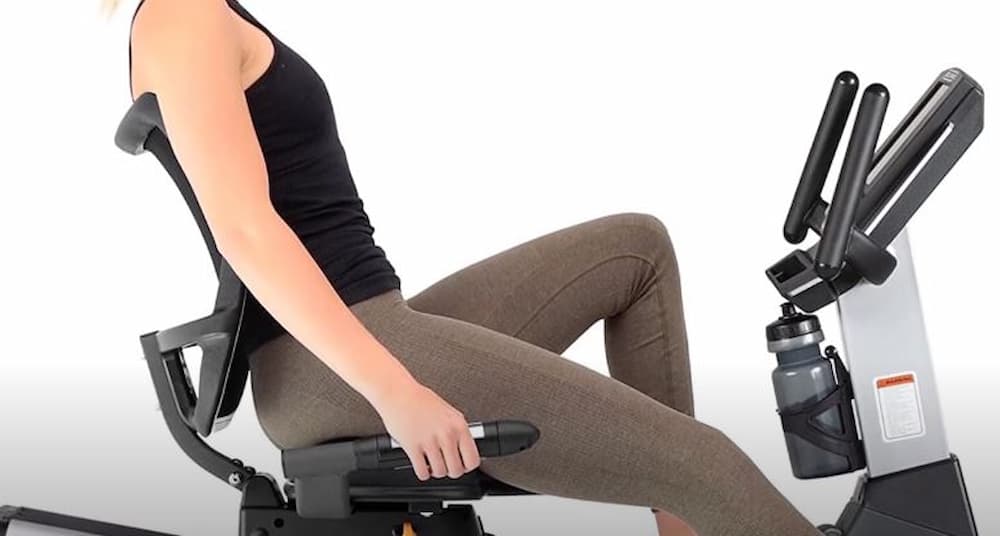The recumbent bike is an excellent cardio fitness equipment that provides seniors with a safe, low-impact form of aerobic exercise. Ageing is not a hindrance to cycling because recumbent bike workouts for seniors are less-strenuous and achievable without encountering injuries.
Even with arthritis, joint pain or balance issues, the recumbent bike can make your fitness plan comfortable and sustainable.
According to Chae-Woo Lee and Gyeong-Hee Cho of the Department of Rehabilitation Science, Graduate School, Daegu University, there was an increase in the step length, step time and Berg balance scale observed in 24 elderly women.
They learned to have exercised on a stationary bike three times a week over a period of 2 months. They concluded that gait and balance are improved and the women have less chance of falling.
Easy Recumbent Bike Workout Suitable for Seniors
Step 1: Warm up for 3 minutes
From an article published under Staying Healthy of the Harvard Health Publishing of the Harvard Medical School, a good warmup is essential before you begin a recumbent bike workout. This will help to prevent injuries, avoid sudden spikes in heart rate, and prepare your body for exercise.
A proper warm-up can be as simple as pedalling slowly for 3 minutes. This will allow your body to adjust to the movement and get your blood flowing.
Warming up helps to increase your range of motion and flexibility, which can help to prevent injuries. It can also help improve your performance by increasing your muscle temperature and blood flow.
What’s more, warming up helps to prepare your body for the demands of the workout by increasing your heart rate, breathing rate, and metabolism.
Now it is time to increase the intensity of your recumbent bike workout. You should go for 25% intensity for two minutes, focusing on your rhythm, posture, and breathing.
This will help you warm up and prepare for the rest of the workout. Be sure to concentrate and gradually increase your heart rate so that you can feel in control of your body.
Step 2: Ramp up 25% intensity for 2 minutes
Now it is time to increase the intensity of your recumbent bike workout. You should go for 25% intensity for two minutes, focusing on your rhythm, posture, and breathing.
This will help you warm up and prepare for the rest of the workout. Be sure to concentrate and gradually increase your heart rate so that you can feel in control of your body.
Focus on rhythm.
When working out on a recumbent bike, it is helpful to focus on the rhythm of your pedalling. This can help you to maintain a consistent pace and avoid getting tired too quickly.
You can try counting your pedal strokes per minute, or simply focus on keeping your pedalling smooth and even. By focusing on the rhythm, you can make your workout more enjoyable and effective.
Maintain a straight posture.
To maintain a straight posture on a recumbent bike workout, sit up straight with your back against the backrest and your shoulders relaxed. Keep your elbows slightly bent and your hands on the handlebars. Avoid leaning forward or slouching, and focus on keeping your core engaged throughout the workout.
Ensure proper breathing.
Proper breathing is important for any workout, but it is especially important for recumbent bike workouts. This is because recumbent bikes are low-impact, which means that they put less stress on your joints.
As a result, you may be tempted to hold your breath during your workout, but this can be harmful. By breathing deeply and regularly, you can help to improve your cardiovascular health and prevent injuries.

Step 3: Cycling goes at 50% intensity for 5 minutes
Now that your body is warmed up, it is time to start the transition to the main part of your recumbent bike workout. Start at a moderate intensity (50%) and maintain this pace for at least 5 minutes.
This will allow you to work up to a higher intensity without feeling too breathless. As you pedal, focus on maintaining good technique and sweating a bit.
Step 4: Cycling goes at 75% intensity for 15 minutes
This is the heart of the workout. You will now increase the intensity to 75%. This will make you sweat yet it will feel great. Focus on your heart rate and maintain it at the listed number (220 minus your age).
If you are crossing the target heart rate, pull back a bit. Adjustments are a part of recumbent bike riding for everyone, especially seniors.
Key factors to consider:
Maintain a steady pace.
To maintain a steady pace on a recumbent bike workout, it is important to find comfortable gear and cadence. The gear should be challenging enough to make you work, but not so challenging that you can’t maintain a conversation. The cadence should be between 60 and 90 RPMs.
Once you have found that sweet spot, focus on keeping your speed consistent. If you find yourself slowing down, increase the resistance or cadence.
If you find yourself speeding up, decrease the resistance or cadence. By maintaining a steady pace, you will get the most out of your workout and avoid injury.
Track your heart rate.
Most recumbent bikes have built-in sensors that you can grip with your hands to measure your heart rate. You can also use a heart rate monitor chest strap or a smartwatch with a heart rate sensor.
Once you have your heart rate, you can use it to track your progress and make sure you are working out at an effective intensity.
A good way to start is to find your target heart rate zone. This is the range of heart rates at which you will get the most benefit from your workout. You can calculate your target heart rate zone using a formula, or you can use a heart rate zone calculator.
Once you know your target heart rate zone, you can use it to guide your workout. Aim to stay in your zone for most of your workout. You can increase or decrease the intensity of your workout by adjusting the resistance level on the bike or by pedalling faster or slower.
Set a rhythm.
To set a rhythm on a recumbent bike workout, find a comfortable cadence (pedalling rate) and resistance level. Then, focus on maintaining a steady rhythm for the duration of your workout. You can use music or a metronome to help you keep a steady beat.
As you get stronger, you can gradually increase the cadence and resistance level to challenge yourself. Setting a rhythm can help you stay focused and motivated during your workout, and it can also help you improve your cardiovascular fitness.
Step 5: Intensity decreases to 50% for 5 minutes
As you near the end of your recumbent bike workout, reduce the intensity to 50%. If you are feeling tired, you can slow down even more. There is no right or wrong way to do this, as you are simply winding down your workout. The goal is to avoid coming to a sudden stop, as this can lead to injuries.

Step 6: Intensity decreases to 25% for 2 minutes
After your workout, reduce the intensity of your recumbent bike workout to 25% and pedal for 2 minutes. This will help your body cool down and prevent injuries. Do not come to a sudden stop, as this can cause your heart rate to drop too quickly and lead to dizziness or fainting.
Key factors to consider:
Check proper timing.
As you near the end of your workout, it is important to check your timing as you slow down. You want to make sure that you are slowing down gradually so that your heart rate can decrease slowly and safely. If you stop too suddenly, you could experience dizziness or fainting.
Stay hydrated.
As you slow down at the end of your workout, it is important to stay hydrated. You may have lost a lot of fluids through sweating during your workout, so it is important to replenish those fluids. Drinking plenty of water or a sports drink will help to rehydrate your body and prevent dehydration.
Put emphasis on breathing.
As you slow down your pace at the end of your workout, focus on your breathing. Breathe deeply and evenly, in through your nose and out through your mouth. This will help to lower your heart rate and blood pressure, and it will also help to prevent muscle soreness. Continue to breathe deeply for a few minutes after you have finished your workout.
Step 7: Slow down to finish the workout session
As you near the end of your recumbent bike workout, slow your pace and continue pedalling lightly for 3 minutes. This will help your body cool down and reduce lactic acid buildup.
Once you are finished, stretch your muscles to prevent soreness. Breathe deeply and evenly, stretch your major muscle groups, and avoid sitting or lying down immediately after your workout.

Final Thoughts
When working out on a recumbent bike as a senior, it is important to pay attention to your body and monitor your heart rate. The plan cited above provides a good starting point for structuring a workout and preparing your body as it warms up. This is even more important for seniors than it is for other age groups.
Just remember these things:
- Start slowly and gradually increase the intensity of your workouts over time.
- Listen to your body and stop if you feel any pain.
- Stay hydrated by drinking plenty of water before, during, and after your workout.
- Wear comfortable clothing and shoes.
- Warm up before starting your workout and cool down afterwards.
By following these tips, you can safely and effectively work out on a recumbent bike and improve your overall health and fitness.
- How Long Should You Stay in a Sauna Safely? - 20 January 2024
- Boost Post-Workout Recovery: Benefits of Using a Sauna for Recovery - 19 January 2024
- Discover the Health Benefits of a Low EMF Infrared Sauna - 19 January 2024
